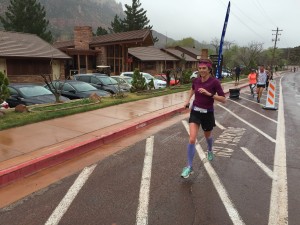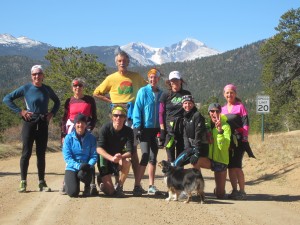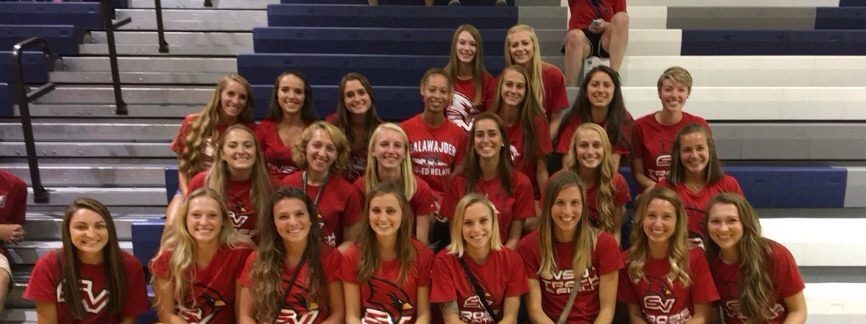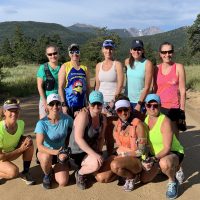Lisa Marshall is an award-winning health and medical science journalist whose work has taken her to parts of Asia, Africa, and Latin America. An avid runner, she lives in the foothills west of Boulder with her husband and two children, and has completed a remarkable ten marathons to date. Here she reflects on her experiences and highlights the inspiration she draws upon to achieve her running goals.
Can you share a little about your running history?
I started running in high school as a way to steal some precious time with my Dad, a busy cardiologist who rarely made it home for dinner and spent most weekends at the hospital. I participated in zero sports and was, frankly, involved in some pretty self-destructive pastimes. But I’d pull myself out of bed instantly when I heard Dad’s knock at 5 a.m. Sometimes we’d run our 3-mile pre-dawn loop in silence, awestruck by the rising sun. Sometimes our footfalls would provide a soundtrack to deep conversations about politics, God, love. Decades later, when Dad began to suffer the early stages of Alzheimer’s disease and I was helping him move into an assisted living facility, I found a copy of Dr. George Sheehan’s 1978 bestseller, “Running and Being” on his bookshelf and asked if I could have it. When I flipped it open, I found it full of underlined passages that spoke to me deeply, making me realize Dad loved running for the same reason I had grown to – its ability to almost instantly provide a fresh perspective. As Sheehan put it: Every day I put on my running clothes, I am born again. Seeing things as if for the first time, seeing the familiar as unfamiliar, the common as uncommon. I’ve since run 10 marathons and dedicated every one of them to my Dad.
 You have been trying different training philosophies recently. What prompted this, and how successful has this been?
You have been trying different training philosophies recently. What prompted this, and how successful has this been?
The first 20 years of my running life were about nurturing my mental health and had very little do to with competition. But at some point I started to realize that in making my body stronger and training for and achieving time goals, I gained discipline and confidence that translated to the rest of my life. Most of the year, I still run without a watch, pay no attention to pace, and let my mind drift. It’s all about the joy. But the last few marathons I’ve trained for I have been more scientific, incorporating regular speed work, long-intervals, heart-rate training, and prescribed paces even for my “long slow” runs. It has mostly gone well – I beat my Boston Qualifying time by 17 minutes in April and my latest marathon was a full hour faster than my first. But I learned some tough lessons. More on that later…
You wanted to qualify for the NYC marathon in 2012 and missed your qualifying mark by just 38 seconds in a half marathon. How frustrating was that for you?
Not really frustrating at all. I love the training – the time I get to spend with friends. And there’s nothing like crossing the finish line and seeing your husband and two daughters (who were pretty little then) holding up signs that say “We love you Mom” and “Sea Level is for Sissies” (this was a Denver race). The next day, ironically, I picked a sea level qualifier (Phoenix) and rallied some friends to road trip with me.
Your next attempt to qualify for NYC was much more successful. What made the key difference for you?
Mental training. No doubt. I have a hip injury that tends to flare up and I often succumb to self-doubt when I get tired. I asked Terry to help me come up with some tools to deal with both of these issues if they arose, and we came up with a mantra: “I feel power. I feel Joy.” And an image (the clock with my goal time on it). I practice these words and this visualization on the plane and on easy runs in the days before my race. Eleven miles in, just about the time I started to fall apart, they came to me unprompted. They didn’t take the pain away, but they reminded me why I run, and what I am capable of. I qualified for NYC by a long shot.
 We recently worked on your mental preparation for the 2016 Boston marathon. Can you share what was happening for you, and how you were feeling?
We recently worked on your mental preparation for the 2016 Boston marathon. Can you share what was happening for you, and how you were feeling?
Six days before the Boston Marathon this year, I felt a dark cloud come over me. I had worked with an excellent exercise physiologist and sports bio-mechanist (Adam St. Pierre), had trained longer and harder for this race than any other, and was in the best shape of my life. But instead of feeling excitement I felt an inexplicable sense of dread and a suffocating tightness in my chest. At 45, I saw this as one of my last chances to PR. I had family members (my sister, three daughters, son in law, Mom and husband) all coming to cheer for me. I’d spent a ton of money and time getting to Boston. And all I could think about was missing that time goal. I got a massage from Jacqui Chiplin (which I always do pre-race) and then came upstairs and asked Terry to help me “screw my head on right.” We sat on the floor together and he instructed: “Try to visualize the last run you were on where you experienced real joy.” The image popped into my head immediately – a light and free me, running past a grain silo painted with bright yellow sunflowers, the sweeping panorama of the Flatirons in the background. I burst into tears and admitted: “It’s been a while.” In this instant, I realized that in my single-minded chasing of the clock, I’d lost touch with my joy.
You came up with a great visual memory that you used to help you prepare for your 2016 Boston race. Can you tell us something about that image, and why it was so important to you?
I pass that grain silo on one of my favorite 20-mile runs. Every time I see it, I smile, because it reminds me to stop looking at my watch, stop taking myself so seriously, breathe deep, take it all in, and be thankful. When I left Terry’s that day I had a new mantra: “Breathe deep. Run free.” And a new image to visualize when it came time to dig deep: My sunflowers.
How do you think your race would have gone for you if you hadn’t decided to refocus your attention?
It was about 70 degrees at the start line in Boston this year so I knew before I started that this was unlikely to be a PR day for me. Rather than punish myself in futile pursuit of that goal time, I decided to make this race all about the joy: I high-fived kids handing out oranges along the sidelines, danced when I passed a band, even stopped – overcome with emotion – to hug a few elderly spectators holding signs that said End Alzheimer’s Now. When I crossed the finish line, I felt more physically and emotionally fresh than I have in previous marathons. And surprisingly, despite the heat, I only missed my PR by 2 minutes.
 You often train with a group of women runners here in Estes Park. How important has the love and support of this group of runners been to your own progress as a runner?
You often train with a group of women runners here in Estes Park. How important has the love and support of this group of runners been to your own progress as a runner?
Words cannot express the gratitude I feel for these women. Through the literally hundreds of miles we have run together, we have become so much more than running partners. They are among my dearest friends and they have made me a better person in so many ways.
What is next in store for you, and can you share your dreams for your running future?
I hate to admit it, but I’m still chasing that PR. I may return to Boston next year, or may shoot for a different marathon course, but I know I have it in me. I just know now that no matter how I train my body, I cannot succeed without tapping into that joy. I’ll remember that next time.
I have seen your self-confidence as a runner soar in recent years. What would you say to someone who is feeling less than confident about themselves as a runner?
The only person you should be comparing yourself to is you yesterday. And before beating yourself up for not “getting faster”, consider all of the relationships you’re forging and all the lessons you are learning about yourself with each step forward. As my Dad taught me, running is about way more than any clock.
Terry provides positive coaching sessions for clients, working with athletes to enable a positive focus on their status and goals. He can also create personalized guided imagery sessions for clients, delivered as an mp3 audio file that you can listen to on multiple devices.
activacuity provides a daily dose of positive guided imagery or visualization sessions. Find out what you can do when you make that mind-body connection – check out our subscription options here.









